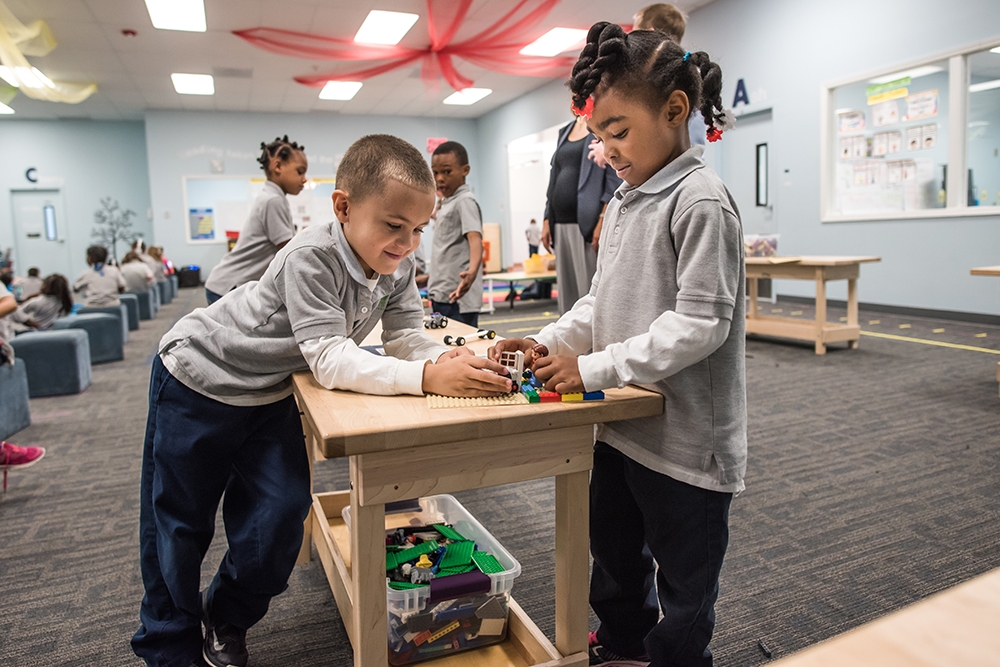
Welcome to another installment of IgnitED Research Insights, which aim to build stronger connections between learning science and instructional practice.
Students benefit from working on a skill or learning target in small groups with others who are at different ability levels in that skill, likely through developing a growth mindset around the target skill and through gaining a better understanding of their own strengths.
In this installment of IgnitED Research, we investigate the power of grouping students who are at different levels on an academic skill.
Let's Face Facts

Working in small groups has been shown to lead to better learning outcomes. Teachers in blended and personalized learning settings often use small group instruction as a strategy for delivering targeted, differentiated instruction to students at a similar level. However, research suggests ability-based grouping is not always the best or equitable approach. For example, being grouped with peers that are more or less advanced in the academic skill the group is working on helps students develop growth mindsets around learning, as well as higher self-efficacy in their academic and non-academic skills. Further, same-ability groups are simpler to implement and benefit high-achieving students, mixed-ability groups benefit all students, especially lower-achieving ones. In addition, grouping in this way can be data-driven, and instruction within these groups can be differentiated.
- Gillies, R. (2014). Cooperative Learning: Developments in Research. International Journal of Educational Psychology, 3(2), 125-140. http://dx.doi.org/10.4471/ijep.2014.08
- Lou, Y. (2013). Within Class Grouping: Arguments, Practices, and Research Evidence. In International Guide to Student Achievement (pp. 180-182). Routledge.
- Webb, N., & Cullian, L. (1983). Group Interaction and Achievement in Small Groups: Stability over Time. American Educational Research Journal, 20(3), 411-423. Retrieved from http://www.jstor.org/stable/1162608
- Park, P., & Datnow, A. (2017). Zooming in on Teacher Data Use Practices: Understanding the Logics of Ability Grouping and Differentiated Instruction. Forum of the American Journal of Education. http://www.ajeforum.com/zooming-in-on-teacher-data-use-practices-understanding-the-logics-of-ability-grouping-and-differentiated-instruction-by-vicki-park-and-amanda-datnow/
Researchers and practitioners agree: mixed-ability grouping is a powerful strategy for students.
“This is an area of education where the practice that happens in schools is far from the research evidence that exists. International analysts conclude that the most successful countries are those that group by ability the latest and the least.”
Jo Boaler, Ph.D.: https://www.youcubed.org/resource/ability-grouping/
“My preference is always for mixed-attainment groups, in all subjects, but I accept that such teaching makes greater demands on teacher skill.”
Dylan Wiliam, Ph.D.: https://twitter.com/dylanwiliam/status/1058787366960316416
“Schools are right to ensure that their pupils are appropriately stretched but it is important that schools and teachers focus on the evidence. If they continue to group pupils by ability, they must monitor carefully the impact that it has on all their pupils.”
Sir Kevan Collins: https://educationendowmentfoundation.org.uk/news/setting-and-streaming-in-schools-our-comment-on-initial-findings-from-eef-t/
Hear from a Practitioner
We talked to educator Nelly Lopez, Learning Facilitator at Lindsay Unified School District in Lindsay, California, who noticed changes in her learners’ growth when she began to create her small groups based on characteristics other than their ability level in the group’s learning target.
Q: How would you describe your process for grouping, and how do you think it improves learning experiences?
A: It's a beautiful chaos because we take into consideration everything that they're bringing and [think] how can I mold three different learners and put them together to help each other? My organizer, my note-taker, all of that -- I'll share that I wish I would have had that as a learner and I still use those abilities and learn from my own peers when I bring it into the lesson plan.
Sometimes working through that frustration builds a lot more knowledge, they get to always reflect.
Q: Is there anything else that you were struck by?
A: The culture that it brings into the setting, I get chills because, they are a family and so... I had always grouped according to academics. Once we started -- it was just that, building the culture. Getting them to really enjoy each other's company and knowledge and being able to freely speak without being ashamed or embarrassed, it's amazing.
Hear the full interview with Nelly Lopez in this video:
Relevance to Blended & Personalized Learning
When considering instructional approaches like small-group or mastery-based individualized instruction, it's important to not only use same-ability groups or isolate students from peers at different ability levels. Students should have opportunities to learn in a variety of settings, including mixed-ability groups.
- Teachers can use technology to keep track of groups, communicate to students which groups they are in for a given learning activity, and move students or create new groups when appropriate.
- Students can use technology as a tool for engaging in collaborative work and taking on different roles within a group to use the skills they are stronger in to help others in the group develop those skills. For example, one student may take notes from a group discussion digitally, another may use a timer to keep the group moving along, while another might do research to answer questions while the group is engaged in completing an assignment or activity to demonstrate mastery of the learning target.
- Technology can facilitate mixed-ability grouping by capturing data about organizational or leadership skills or even roles a student has taken on in previous groups (any academic or other skills related to a learning target) that can be used to create and re-create groups.
Learn More
To learn more about the research and benefits of mixed-ability groups for all students, take a look at:
- Education Endowment Foundation’s Evidence Summaries: Within-class Attainment Grouping
- Park, V., & Datnow, A. (2017). Ability grouping and differentiated instruction in an era of data-driven decision making. American Journal of Education, 123(2). https://doi.org/10.1086/689930
- Edutopia's blog post on Student Learning Groups: Homogeneous or Heterogeneous?
- How do I ensure rigor and high expectations for the whole student in blended/personalized learning classrooms?
- How do I deepen differentiation and personalization within a station rotation model?
